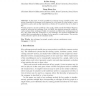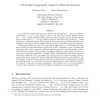215 search results - page 40 / 43 » Efficient Identity-Based Signatures Secure in the Standard M... |
JUCS
2008
13 years 9 months ago
2008
: In the paper we study parallel key exchange among multiple parties. The status of parallel key exchange can be depicted by a key graph. In a key graph, a vertex represents a part...
CCS
2010
ACM
13 years 6 months ago
2010
ACM
Cryptographic systems and protocols are the core of many Internet security procedures (such as SSL, SSH, IPSEC, DNSSEC, secure mail, etc.). At the heart of all cryptographic funct...
ICS
2010
Tsinghua U.
14 years 7 months ago
2010
Tsinghua U.
We introduce the notion of "non-malleable codes" which relaxes the notion of error-correction and errordetection. Informally, a code is non-malleable if the message cont...
ASIACRYPT
2008
Springer
13 years 11 months ago
2008
Springer
In an oblivious transfer (OT) protocol, a Sender with messages M1, . . . , MN and a Receiver with indices 1, . . . , k [1, N] interact in such a way that at the end the Receiver ...
EUROCRYPT
2009
Springer
14 years 10 months ago
2009
Springer
A group key agreement (GKA) protocol allows a set of users to establish a common secret via open networks. Observing that a major goal of GKAs for most applications is to establish...


